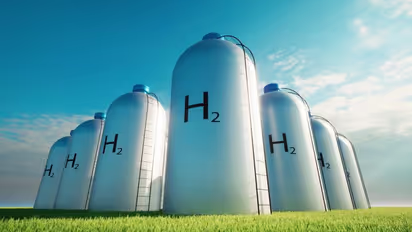India announces definition of Green Hydrogen

Synopsis
Green Hydrogen Standard for India specifies an emission threshold of 2 kg CO2 equivalent/kg H2 as a 12-month average. The parameters encompass hydrogen derived from both electrolysis-based and biomass-based production methods.
Marking a significant stride towards the advancement of the National Green Hydrogen Mission, a pivotal development has occurred as the Indian government has officially introduced the Green Hydrogen Standard for India. This standard, issued by the Ministry of New and Renewable Energy (MNRE), Government of India, delineates the emission benchmarks that must be met to classify hydrogen production as 'Green,' originating from renewable sources.
The parameters encompass hydrogen derived from both electrolysis-based and biomass-based production methods. Following consultations with diverse stakeholders, the Ministry of New & Renewable Energy has defined Green Hydrogen as hydrogen with well-to-gate emissions (including water treatment, electrolysis, gas purification, hydrogen drying, and compression) not exceeding 2 kg CO2 equivalent per kg H2.
The notification stipulates that the Ministry of New & Renewable Energy will define an elaborate methodology for measuring, reporting, monitoring, on-site verification, and certifying green hydrogen and its derivatives.
Additionally, the Bureau of Energy Efficiency (BEE), under the Ministry of Power, will serve as the Nodal Authority responsible for accrediting agencies for monitoring, verifying, and certifying Green Hydrogen production projects.
The introduction of the Green Hydrogen Standard through this notification brings a much-needed clarity to India's Green Hydrogen community and has been eagerly anticipated. With this, India joins the ranks of the world's first few countries to establish a definitive definition for Green Hydrogen.
This announcement follows closely after statements by Power and New and Renewable Energy Minister R K Singh, who projected India's imminent emergence as a major global producer of green hydrogen.
In detailing the nation's journey in infrastructure expansion, Singh attributed India's competitive advantage in green hydrogen production to its rapidly advancing renewable energy sector.
Singh asserted, "We have already emerged as one of the larger manufacturers of green hydrogen and green ammonia," underlining that India's renewable energy cost is the most economical worldwide.
The minister underscored India's inherent advantages and swift transition to non-fossil fuels as pivotal factors in its potential dominance within the realm of green hydrogen manufacturing. With a non-fossil fuel-powered capacity of 185,000 MW, constituting 43% of the total capacity, and an additional 88,000 MW under installation, India's renewable energy sector is forging ahead with remarkable momentum.
Stay updated with the Breaking News Today and Latest News from across India and around the world. Get real-time updates, in-depth analysis, and comprehensive coverage of India News, World News, Indian Defence News, Kerala News, and Karnataka News. From politics to current affairs, follow every major story as it unfolds. Get real-time updates from IMD on major cities weather forecasts, including Rain alerts, Cyclone warnings, and temperature trends. Download the Asianet News Official App from the Android Play Store and iPhone App Store for accurate and timely news updates anytime, anywhere.